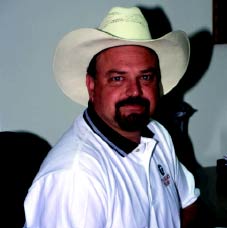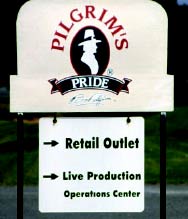COCCI Focus
Fine tuning timing and management helped Pilgrim's Pride master the art of coccidiosis vaccination.
 McIntyre: 'We achieved good success with our new
schedule.'
|
Managing coccidiosis has
always been a high priority
for Pilgrim's Pride, a Texasbased
poultry producer that last year
marketed some 2.5 billion pounds of
chicken in the United States and
Mexico.
In January 2001, the company
acquired the Harrisonburg, Va.-based
Wampler Foods, including a broiler and
turkey operation in
Marshville, N.C. Since
then, management
objectives at the
Marshville site have
included implementing
more alternatives
to in-feed anticoccidials
and finding a cost
advantage in doing so.
"Of all the diseases
associated with broiler
production, coccidiosis
has the biggest
impact on performance,"
says Dr. Beth
Krushinskie, corporate
veterinarian for the
Pilgrim's Pride Eastern
Division, based in
Harrisonburg, Va. "Therefore, controlling
coccidiosis is a producer's biggest
opportunity to increase profitability."
Room for improvement
Controlling coccidiosis might also be a producer's greatest opportunity to improve flock health."Coccidiosis is not completely under control in the poultry industry and there is still a lot of room for improvement," Krushinskie says, "but our coccidiosis- vaccination program works great for us, and we believe vaccination is an effective tool for large bird growout operations."
The veterinarian reports seeing no major reaction problems following the use of Coccivac®-B, a live-oocyst coccidiosis vaccine. In fact, while Pilgrim's Pride does not release production figures, the Marshville operation has seen excellent bird performance while using Coccivac-B in its anticoccidial program, according to Don McIntyre, live operations manager.
"Coccidiosis is a burden that hangs over us all the time, and we are limited in the number of options available to control the disease," Krushinskie adds. "The vaccine is one 'step-out-of-thebox' tool that really helps to alleviate the problem."
Commitment to health
Pilgrim's Pride's North Carolina complex
processes some 650,000 birds a
week. Because of its commitment to a
total health program, the operation
now ranks in the top 25% for low condemnation
and typically experiences
96% livability per week. The company's
North Carolina coccidiosis-vaccination
program didn't always run that smoothly,
however.
Back in December 1999, when the
operation was still owned by Wampler,
it started vaccinating for coccidiosis
instead of using in-feed anticoccidials.
But the results weren't pretty.
"Houses became wet and birds
experienced enteritis between 2 and 3
weeks of age," McIntyre relates.
The problem was traced not to the
vaccine, but to several management
issues, according to Dr. John McCarty,
Plantation, Fla., a consulting veterinarian
for Schering-Plough Animal Health
Corporation who worked closely with
Wampler and now Pilgrim's Pride
The biggest problem, McIntyre says,
focused on which day chicks were
released from the brood area. The company
had been turning birds into the
full house around day 14 during winter
months and about day 11 during warm
weather.
At the advice of McCarty and other
Schering-Plough Animal Health veterinarians,
Pilgrim's tweaked their coccidiosis-
vaccination schedule and
changed to a summertime regime when
birds entered the full house at a
younger age.
In 2000, the North Carolina complex
vaccinated for coccidiosis in August
and September. In 2001 the vaccine
was used from June through October,
and this year from May through
October. The vaccine, which contains
live oocysts that are highly sensitive to
the more traditional anticoccidials,
helped to seed poultry houses with
more manageable strains of Eimeria,
and set the stage for more effective
anticoccidial usage in fall and winter.
Humble Beginnings, Incredible Growth
The Pilgrim's Pride success story began
in 1946 with two industrious brothers,
$1,000 cash and a $2,500 bank note to be
repaid in monthly installments. |
Seasonal considerations
"That's not to say that coccidiosis vaccination
is more effective in the warmer
months," McCarty points out.
"Coccidiosis vaccine can be used in any
season as long as moderately dry litter
conditions can be maintained and
stocking density can be managed to
control the vaccination reaction. Some
companies, however, find it difficult to
use coccidiosis vaccine in winter
because ventilation is reduced and
birds are held in the partial house
longer than 14 days."
"We achieved good success with
our new schedule," McIntyre says. "The
most important thing we learned was
that in order for vaccination to be successful,
birds have to be out of the
brood chamber and into the whole
house before 12 days of age."
"For vaccinated birds, we recommend
making that transition to full
house between 7 and 10 days of age
during warm weather," McCarty says.
Right from the start
 Tomberlin: '"�it's critical to vaccinate
during a time period that's
both good for the birds and good
for the contract growers.'
|
Under the direction of hatchery manager
Doug Jones, Pilgrim's Pride vaccinates
for coccidiosis in the hatchery on
day 1, using the Spraycox® cabinet "a
specially designed applicator that
showers birds with the vaccine. A red
dye supplied with Coccivac-B helps to
monitor vaccine coverage, while also
encouraging preening among the
chicks.
This process, McCarty explains,
actually helps birds ingest the live vaccine's
oocysts that help them build natural,
lifelong immunity to the costly disease
"an important consideration
when feeding larger birds. At its
Marshville complex, Pilgrim's Pride
grows chickens to about 56 days, or an
average live weight of 7 pounds per
bird.
"The first vaccination dose cycle
provides the greatest management
challenges relative to coccidiosis control,"
McCarty points out. "However,
the first cycle dose seeds the litter with
live oocysts, and once the litter is seeded
down, it becomes easier to manage
the birds during later cycles."
Trouble-free transition
Broiler grow-out manager Terry Tomberlin helps to oversee Marshville's 80 to 85 grower operations that produce 80,000 to 222,000 birds each in a wide variety of building styles and sizes. He says the switch to Coccivac-B coccidiosis vaccine has been virtually trouble-free since changing the coccidiosis vaccination schedule and the day on which birds go into the full house."Our birds have experienced few adverse reactions and very little, if any, enteritis," he says. "Having to work through the initial problems and learning to use the vaccine to our best advantage has made us better managers. We now realize that, for our operation, it's critical to vaccinate during a time period that's both good for the birds and good for the contract growers."
Since implementing a warm-weather vaccination schedule into its coccidiosis control regime, the Marshville complex hasn't made any major management changes other than moving birds into full house by 12 days of age. "Our birds require very little medication, because we strive to manage our way out of problems," Tomberlin says.
Sanitation is also a major priority.
"We clean our buildings and change litter once a year," McIntyre reports. "Half of our growers clean in the spring, the other half during the fall. The down time generally runs 12 to 14 days."
Good communication essential
A team effort has been critical in the
Pilgrim's Pride coccidiosis-control program,
adds Tommy Long, feed mill
manager in Marshville. He oversees
ingredient purchasing, milling and
delivery.
"Good communication with the
feed mill is critical to the successful
transition of a coccidiosis-vaccination
program," Long emphasizes. "Accidentally
feeding medicated feed to a vaccinated
flock could kill the vaccinal
organisms and interrupt the immunization
process. Even worse, mistakenly
giving unmedicated feed to a flock that
hasn't been vaccinated could cause a
full-blown coccidiosis outbreak."
"We're accustomed to dealing with a
number of different feed formulas all
the time, but there are logistics concerns
we've had to work out regarding
bin space for medicated and unmedicated
feed," Long says.
"Communications are also important
in making certain that flocks get feed
with coccidiostats according to the designated
schedule."
While Pilgrim's Pride won't comment
on the exact savings associated
with using a coccidiosis vaccine in its
program, McIntyre says, "We find the
vaccine very cost-effective compared to
in-feed anticoccidials. I really believe in
the product."
Source: CocciForum Issue No.5, Schering-Plough Animal Health.








